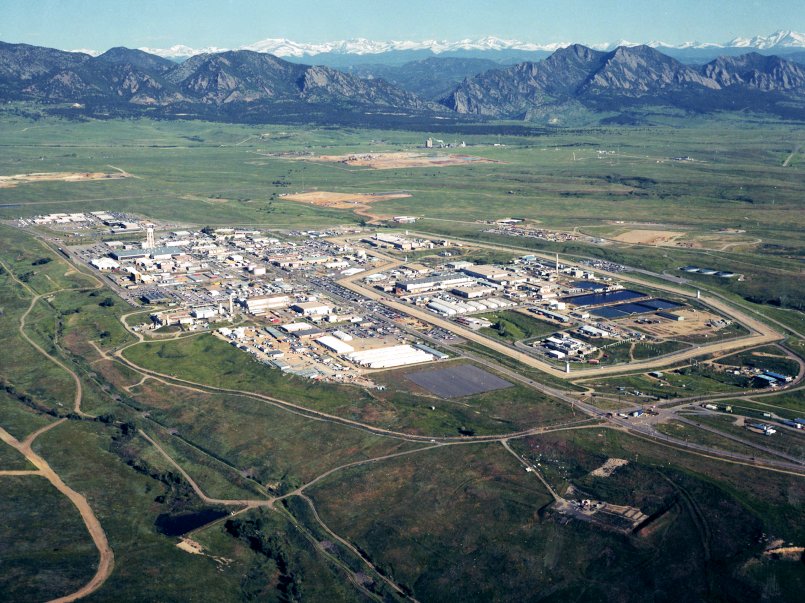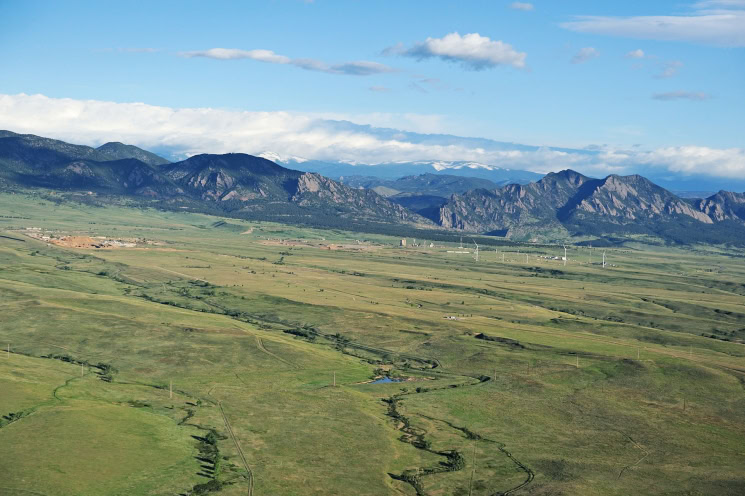
By Micha K. Ben David, Giselle Herzfeld and Michael Gayner
On the surface, building an overpass and underpass to allow safe crossing for bicyclists traversing a regional biking trail network seems like a great idea. Crossing busy streets on a bike can be dangerous, and if there’s one thing Coloradans can agree on, it’s how deeply we value access to our beautiful outdoor landscapes.
But what if the landscape to which we are facilitating access happens to be one of the most radioactively contaminated areas in the country?
You may be familiar with the infamous Rocky Flats, a former nuclear weapons plant that produced 70,000 plutonium pits for nuclear bombs during the Cold War. The site was shut down in 1989 after an FBI raid uncovered an array of environmental crimes that left a 240,000-year radioactive scar on our beautiful Front Range.
Only the area where the plutonium pits themselves were manufactured, known as the “central operable unit,” received a modest cleanup. It remains a designated EPA Superfund site to this day.
The rest of the site was designated as a wildlife refuge that opened to the public in 2018. Even before the refuge officially opened, local governments surrounding Rocky Flats began efforts to develop a biking trail encircling the most contaminated part of Rocky Flats, dubbed the “Rocky Mountain Greenway.”
Unsafe at a cellular level
At the heart of the debate are the dangers of the plutonium that exists in the area. Plutonium is widely understood as one of the most dangerous radioactive elements known to man, and for good reason. Inhaling even a tiny particle can lead to serious health issues, including cancer, immune deficiencies, birth defects and a wide array of other health problems.
Proponents of the Greenway point to the fact that plutonium emits alpha radiation, which has a low range of radioactivity. At the particulate level, it can be relatively harmless, as long as it stays outside your body.
The danger lies in the fact that there are widespread particles of plutonium onsite that can very easily enter the body through inhalation, ingestion or an open wound. When a plutonium particle becomes lodged in one’s body, it can wreak havoc at the cellular level. The particle is very likely to remain in the body for the rest of one’s life; it will continuously bombard surrounding cells with radiation. It may take years before a tumor develops, and by then one would have no idea it developed due to a scenic bike ride through a former nuclear weapons plant years prior.
Rocky Flats is a dry, dusty area, with virtually no signage to inform the public of the history and current contamination of the site. Thousands of people move to the Colorado Front Range each year with no knowledge of the history of the site, a history which has been effectively obscured from the public by the U.S. Department of Energy.
By moving forward with this project, local governments risk potentially exposing thousands of unknowing people, including children and pregnant women, to plutonium and other radioactive materials.
Contamination plume
The history of Rocky Flats is fraught with environmental scandals. Between 1952 and 1989, the Rocky Flats Plant experienced two major plutonium fires that blew radioactive particles across the surrounding metropolitan area, as well as a string of dangerously irresponsible waste disposal and storage failures — including the “903 pad,” where 5,000 metal barrels full of radioactive waste were left outside to corrode for 11 years, leaking all that waste into the ground and surrounding waterways.
After the site was shut down, full cleanup of the site was estimated by the Department of Energy to cost $36 billion and take 65 years. But what the public got was only a partial cleanup totaling $7.3 billion and ending in 2005. That’s $30 billion dollars and 60 years of cut corners in cleanup, for all the mess that was created there.
As a result of these cut corners in cleanup, the Rocky Flats area is still widely contaminated with plutonium particles, as well as other hazardous waste such as americium, beryllium, uranium and radioactive lead, among many others. Evidence shows that contamination is still widespread in the area, with materials that can remain radioactive for hundreds of thousands of years. Maps have been created to track the intensity, direction and shape of the plutonium contamination plume that stretches into the communities east of Rocky Flats.
In a significant recent scientific discovery, air testing by Dr. Michael Ketterer found airborne plutonium particles originating from Rocky Flats. Air filter samples were collected to the east of Rocky Flats during a high-wind event on April 6, 2024, and weapons-grade plutonium was detected in two samples. This study demonstrated that during high-wind episodes, contaminated soil is being carried across Rocky Flats and even offsite, with the potential to expose anyone downwind to plutonium inhalation.

Vested interests
The Colorado Front Range, with its vast scenic landscapes, is a rapidly growing area experiencing a major population and development boom. Enormous wealth has already been invested in housing and infrastructure in the neighborhoods around Rocky Flats.
The truth about the level and danger of contamination threatens those investments for property owners and local governments — not to mention the potential liabilities.
The implications for similar locations around the United States — where contamination has been ignored, minimized or misconstrued — are incalculable. A defining moment in this history was conveyed by Dr. Carl Johnson, former executive director of Jefferson County Public Health, when he wrote a 1988 op-ed in the New York Times titled “Rocky Flats: Death Inc.” Johnson traced his history as a whistle blower warning of developing land downwind of Rocky Flats; he was subsequently fired.
A second, even more insidious interest in promoting the Rocky Mountain Greenway, is a desire to normalize and greenwash the production of nuclear weapons so that production can continue indefinitely.
As of 2021, the United States Congressional Budget Office has committed upward of $2 trillion over the next 30 years to modernize our nation’s nuclear weapons arsenal, a move which will require the production of new plutonium pits. A majority of this plutonium pit production is set to take place at the Savannah River Site in South Carolina, and the facility in which the pits will be produced is slated to cost$25 billion.
Normalizing former plutonium facilities as safe makes it easier to expand plutonium production to new sites. When a community accepts the presence of radioactive contamination and uses contaminated land for living and recreation, those who should be responsible for proper cleanup and safe decontamination are granted a free pass to continue polluting without ever cleaning up their messes.
What you can do
The tides may be turning as more local governments and organizations are stepping up to take a stand against the Rocky Mountain Greenway project.
In 2018, seven school districts banned field trips on Rocky Flats. In 2016, the Superior Board of Trustees rejected the Greenway project outright, and Broomfield voted unanimously to withdraw their support from the project in 2020. More recently, Westminster City Council held a July study session featuring expert presentations on the risks of moving forward with the Greenway project, which may foretell their withdrawal from the project.
Development of an overpass in Westminster and underpass in Boulder County linking Rocky Flats trails to a wider network of regional trails is set to move forward as early as Sept. 9, if no immediate actions are taken by the local governments involved. It is now more important than ever that these governments hear directly from their constituents that they do not want this project to move forward.
Reach out to your elected officials and demand that they withdraw from the Rocky Mountain Greenway project to protect public health and safety. Together, we can ensure a safer, healthier future for ourselves and generations to come.
You can start by sending a letter: tinyurl.com/NoBoCoRMG
Members of the Rocky Mountain Peace & Justice Center, The Climate Justice Hive and The Nuclear Nexus contributed writing.
This opinion does not necessarily represent the views of Boulder Weekly.
